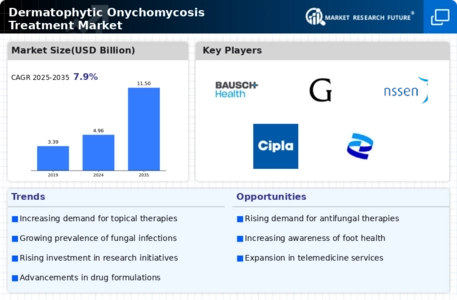Market Trends
Key Emerging Trends in the Dermatophytic Onychomycosis Treatment Market
Dermatophytic onychomycosis, a common fungal infection affecting the nails, has spurred significant market trends in treatment options over the past decade. As one of the most prevalent nail disorders globally, the demand for effective remedies has driven innovation and growth within the dermatophytic onychomycosis treatment market. One notable trend involves the development of topical antifungal agents, which have gained popularity due to their ease of application and favorable safety profiles. These formulations, often containing ingredients such as terbinafine or ciclopirox, offer patients a convenient and non-invasive treatment option.
In addition to topical treatments, oral antifungal medications have remained a cornerstone in the management of dermatophytic onychomycosis. Drugs like terbinafine and itraconazole have demonstrated high efficacy rates in clinical trials, contributing to their widespread adoption among healthcare providers and patients alike. However, concerns regarding potential adverse effects and drug interactions have prompted ongoing research efforts aimed at improving the safety and tolerability of oral antifungal therapies.
Furthermore, the emergence of novel therapeutic modalities has expanded the treatment landscape for dermatophytic onychomycosis. Laser therapy, for instance, has garnered attention as a promising alternative to traditional pharmacological interventions. By targeting fungal pathogens while sparing surrounding healthy tissue, lasers offer a potentially safer and more targeted approach to onychomycosis treatment. Despite initial optimism, however, the clinical efficacy and long-term outcomes of laser therapy remain subjects of ongoing investigation and debate within the medical community.
Moreover, advancements in diagnostic techniques have played a crucial role in shaping market trends within the dermatophytic onychomycosis treatment landscape. The introduction of molecular assays and polymerase chain reaction (PCR) technology has revolutionized the accurate identification of causative fungal species, enabling healthcare providers to tailor treatment regimens more precisely. Furthermore, the growing emphasis on personalized medicine and targeted therapies has spurred the development of companion diagnostic tools designed to guide treatment decisions and optimize patient outcomes.
Another notable trend in the dermatophytic onychomycosis treatment market pertains to the rising demand for over-the-counter (OTC) remedies and home-based interventions. With an increasing number of consumers seeking convenient and cost-effective solutions for nail fungus, the availability of OTC antifungal products has surged in recent years. From medicated nail lacquers to antifungal creams and ointments, these over-the-counter options cater to individuals looking to manage mild to moderate cases of onychomycosis without the need for prescription medications or medical intervention.
Furthermore, the integration of digital health technologies and telemedicine platforms has facilitated greater access to dermatophytic onychomycosis treatment options, particularly in underserved or remote regions. Through virtual consultations and mobile health applications, patients can connect with dermatologists and healthcare providers, receive timely diagnosis and treatment recommendations, and access educational resources to better understand their condition and available therapeutic interventions.


 Source: Secondary Research, Primary Research, Market Research Future Database and Analyst Review
Source: Secondary Research, Primary Research, Market Research Future Database and Analyst Review





Leave a Comment